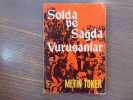5 books for « toker »Edit
-
Type
Book (4)
Music sheets (1)
-
Topics
Architecture (2)
Cult (1)
Florence (1)
History (2)
Nazism (1)
Religions (1)
Scores (1)
Songs (1)
Tea (1)
-
Countries
Belgium (2)
Canada (1)
France (2)
-
Syndicate
ALAC (1)
ILAB (1)
Solda Ve Sagda Vurusanlar.
Akis Yalinlari S.L. 1971 In-8 carré ( 240 X 160 mm ) de VIII-177 pages, broché sous couverture illustrée. Une planche dépliante. Bon exemplaire.
Partition de la chanson : S'aimer sur l'herbe
Raillet René 1930 approx.
Bon état Petit format
On Holy Ground: Liturgy, Architecture and Urbanism in the Cathedral and the Streets of Medieval Florence,
Turnhout, Brepols, 2009 Hardback, IV+324 p., 52 b/w ill., 220 x 280 mm. ISBN 9781905375516.
On Holy Ground: Liturgy, Architecture, and Urbanism in the Cathedral and in the Streets of Medieval Florence asks just one question: had the Florence Duomo never been excavated, what could we have known of the legendary cathedral of S. Reparata below it? The answer comes through the transcription of two key texts: one, never published until now, was written for the cathedral clergy around 1190; the other was composed around 1230, and printed just once, in the eighteenth century. English translations bring to life the liturgical year in medieval Florence, from the gorgeous pageantry of Christmas to the plaintive rites of Easter. The archaeological finds now make sense of the chapels, altars, and hallowed tombs that are cited in the texts. The volume then reconstructs the canonry (torn down around 1840), where the officiating priests lived, and the neighboring buildings on the cathedral square: a hospital, a school, and a prominent city gate that long ago disappeared, and a Baptistery, bishop's palace, and confraternity headquarters that are still standing. One chapter is devoted to the religious processions that ventured forth from S. Reparata to wind through the streets of Florence. Here the old texts are brought to life by the towers, bridges, churches, and monuments that survive from medieval Florence. The processional routes are examined for their social, political, and economic importance to the cathedral clergy, and the way the routes delineated the main lines of Roman Florence. The final chapter explores the food that poured onto the tables of the cathedral clergy from the farms and villages of the Florentine countryside. Altogether, the volume provides an exceptional look at the physical and spiritual impact of Florence's thousand-year-old cathedral in the age of Dante. Language : English, Latin.
Archaeological Campaigns below the Florence Duomo and Baptistery, 1895-1980
, Brepols, 2013 Hardback, 536 p., 591 b/w ill. 124 colour ill., 220 x 280 mm, Languages: English. ISBN 9781905375523.
Based on the excavations of 1965-1980, this second volume in the series provides an overview of the medieval art and architecture that was found below the Florence Duomo and Baptistery Archaeological Campaigns below the Florence Duomo and Baptistery, 1895-1980 presents the results of one of the major archaeological campaigns of our times: the decade-long excavation below Florence's cathedral of S. Maria del Fiore. The book presents a cutaway vision of a great city that would be hard to match anywhere, exploring a site that was in use for 1500 years, from the founding of the Roman settlement of Florence to the burial there of Giotto and Brunelleschi. In terms of structures, the excavation uncovered a Roman house, an Early Christian basilica, a Carolingian crypt, and further rebuildings from the eleventh century and later. For artifacts, the findings constitute a virtual encyclopedia of ancient and medieval art in mosaics, frescoes, the grave of Florence's earliest documented saint, the first elaborate tomb of the Medici, and outstanding examples of Roman and medieval glass, metalwork, and ceramics. Forty-one specialists in material culture and archaeological science report on those finds in the book, and hundreds more illustrations are carried on the author's website, www.franklintoker.com. But the findings from below the Florence Duomo are not limited to art history. The Roman house gives a glimpse of life on the Italian peninsula in the half-millennium between Emperor Augustus and the Ostrogoth king Theodoric. The construction of a large basilica with its rich mosaic floor marks the evident revival of a battered city: a turn of events entirely unexpected from the few other fragments of early Florentine history that survive. The later additions to the church of S. Reparata (as the early cathedral was titled by then) also constitute rare remains from the turbulent centuries that followed. Archaeological Campaigns additionally caries the results of excavations at the Baptistery of Florence and digging to establish the construction history of S. Maria del Fiore. The excavation results for S. Reparata, S. Giovanni, and S. Maria del Fiore make a fundamental contribution to the history of a city that has itself contributed so much to western civilization
L'Église Notre-Dame de Montréal, son architecture, son passé
Hurtubise-HMH Couverture souple Montréal 1981
Très bon In-8. 302 pages. "Cahiers du Québec, coll. "Beaux-Arts". Illustrations.
 Write to the booksellers
Write to the booksellers



